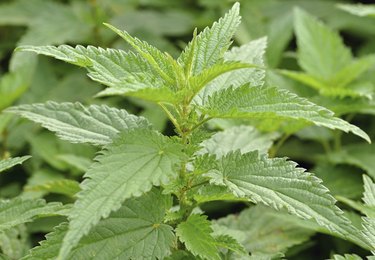
Whether you live in the north or the south, chances are you've probably run into stinging nettle (Urtica dioica) at some time in your lawn. This widespread perennial covered with stinging hairs grows in U.S. Department of Agriculture plant hardiness zones 3 through 9, and is native to nearly every state. Fortunately you can kill its sting in your lawn through mowing, hand pulling or chemical sprays.
Mow It Often
Video of the Day
One stinging nettle plant can produce 20,000 seeds creating large patches of the plant in your lawn. One way to kill it is through repeated and frequent mowing. This makes it so the plant is not able to produce seed, and overtime the plant weakens and eventually dies. To kill stinging nettle through mowing, set the mower deck at the recommended height for your grass species and mow at least once per week, or before stinging nettles plants are able to set new seed. If plants have set seed use a bagger attachment on the mower to prevent spreading the seeds.
Video of the Day
Pull It
Stinging nettle not only scatters by air-borne seeds, but it also spreads by underground rhizomes. If you only have a few plants dotting an area of your lawn you can kill them by digging around the plant with a hoe or trowel deep enough to dislodge the roots, then pull the roots and rhizomes out by hand. Plastic the plant in a plastic bag and dispose or it in the trash. Any portion of a stinging nettle rhizome can regenerate the plant so be sure to pick up all pieces of it. Also, protect yourself from the plant's sting by wearing heavy gloves, long pants and a long-sleeve shirt. It may take several sessions of removing plants by hand to kill a stand of nettle, so be patient and remove plants as soon as you see them.
Spray It
A ready to use product containing a combination of the active ingredients 2,4-D, dicamba and Mecoprop-p dimethylamine salts can be used on stinging nettle in most species of grass without harming the grass. When nettle appears in the lawn during the growing season, spray a light coating of herbicide on it and allow the herbicide to dry completely before irrigating the lawn; some products recommend allowing at least six hours to dry. If rain is expected, spray nettle early enough that herbicide dries before it rains. To prevent injury to the grass or nearby plants use weedkiller sparingly only in areas with nettle, don't spray on a windy day when drift can harm unintended plants, and don't spray on stinging nettle under trees because weedkiller can leach into the ground and harm roots of trees or shrubs. Follow all warnings on the label, such as what temperature range it can be safely used in and what species of grass the weedkiller can be used on without harming it. Some products may require nettle to be actively growing for the product to work, if so it will be stated on the label. Also, wear protective eyewear, rubber gloves, long sleeves and long pants when working with chemicals.
Compost It
Though stinging nettle is considered a weed in the lawn, it does have a redeeming quality. Nettle that has been removed by hand pulling, doesn't have seed pods, and has not been sprayed with chemicals can composted. Before tossing the entire plant, roots and all, into the pile allow it to dry for at least two days by laying it out on a sidewalk or driveway. The high nitrogen content in stinging nettle draws in earthworms, which breakdown organic material in the pile.